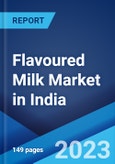The flavoured milk market in India size reached INR 41.6 Billion in 2022. Looking forward, the publisher expects the market to reach INR 158.6 Billion by 2028, exhibiting a growth rate (CAGR) of 25.8% during 2023-2028.
Flavoured milk represents one of the most popular dairy-based beverages in India. It is made by adding sugar, emulsifiers and flavours such as vanilla, chocolate, mango, butterscotch, etc. to skim or whole fluid milk. It is a convenient, flavoursome and healthy alternative to carbonated beverages, as a result of which, it is preferred by both school going children as well as working adults. The strong growth of the market can be attributed to the rising health consciousness among consumers which has led to a shift towards dairy based products. Some of the other growth inducing factors include increasing disposable incomes and growing population.
The study gives an in-depth analysis of the flavoured milk market landscape in India, covering the current, historical and future trends for flavoured milk production along with its prices. The report also offers SWOT, Value Chain and Porter’s Five Forces analysis of the Indian flavoured milk market along with breakup by segment, region, and an analysis of the competitive landscape. The study is based on both desk research and multiple waves of qualitative primary research. This report is a must-read for entrepreneurs, investors, researchers, consultants, business strategists, and all those who have any kind of stake or are planning to foray into the Indian flavoured milk industry in any manner.
2. What is the expected growth rate of the flavoured milk market in India during 2023-2028?
3. What are the key factors driving the flavoured milk market in India?
4. What has been the impact of COVID-19 on the flavoured milk market in India?
5. What is the breakup of the flavoured milk market in India based on the sector?
6. What are the key regions in the flavoured milk market in India?
7. Who are the key players/companies in the flavoured milk market in India?
Flavoured milk represents one of the most popular dairy-based beverages in India. It is made by adding sugar, emulsifiers and flavours such as vanilla, chocolate, mango, butterscotch, etc. to skim or whole fluid milk. It is a convenient, flavoursome and healthy alternative to carbonated beverages, as a result of which, it is preferred by both school going children as well as working adults. The strong growth of the market can be attributed to the rising health consciousness among consumers which has led to a shift towards dairy based products. Some of the other growth inducing factors include increasing disposable incomes and growing population.
The report has examined the Indian Flavoured Milk Market in 15 major states:
- Maharashtra
- Uttar Pradesh
- Andhra Pradesh and Telangana
- Tamil Nadu
- Gujarat
- Rajasthan
- Karnataka
- Madhya Pradesh
- West Bengal
- Bihar
- Delhi
- Kerala
- Punjab
- Orissa
- Haryana
The study gives an in-depth analysis of the flavoured milk market landscape in India, covering the current, historical and future trends for flavoured milk production along with its prices. The report also offers SWOT, Value Chain and Porter’s Five Forces analysis of the Indian flavoured milk market along with breakup by segment, region, and an analysis of the competitive landscape. The study is based on both desk research and multiple waves of qualitative primary research. This report is a must-read for entrepreneurs, investors, researchers, consultants, business strategists, and all those who have any kind of stake or are planning to foray into the Indian flavoured milk industry in any manner.
Key Questions Answered in This Report
1. What was the size of the flavoured milk market in India in 2022?2. What is the expected growth rate of the flavoured milk market in India during 2023-2028?
3. What are the key factors driving the flavoured milk market in India?
4. What has been the impact of COVID-19 on the flavoured milk market in India?
5. What is the breakup of the flavoured milk market in India based on the sector?
6. What are the key regions in the flavoured milk market in India?
7. Who are the key players/companies in the flavoured milk market in India?
Table of Contents
1 Preface3 Executive Summary12 Loans and Financial Assistance14 Key Player Profiles
2 Scope and Methodology
4 Introduction
5 India Dairy Industry
6 India Flavoured Milk Industry
7 Performance of Key Regions
8 Market Breakup by Retail Vs Institutional
9 Competitive Landscape
10 Flavoured Milk Manufacturing Process
11 Project Details, Requirements and Costs Involved
13 Project Economics
Companies Mentioned
- GCMMF
- Mother Dairy
- KMF
- CavinKare
- TN Cooperative
Methodology

LOADING...
Table Information
| Report Attribute | Details |
|---|---|
| No. of Pages | 149 |
| Published | September 2023 |
| Forecast Period | 2022 - 2028 |
| Estimated Market Value ( INR | INR 41.6 Billion |
| Forecasted Market Value ( INR | INR 158.6 Billion |
| Compound Annual Growth Rate | 25.0% |
| Regions Covered | India |
| No. of Companies Mentioned | 5 |









